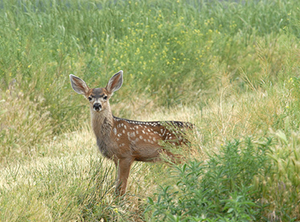 Blacklegged ticks, both the Western and Eastern varieties, are often known as “deer ticks” … Does that mean deer are to blame for the spread of Lyme disease?
Blacklegged ticks, both the Western and Eastern varieties, are often known as “deer ticks” … Does that mean deer are to blame for the spread of Lyme disease?
Perhaps surprisingly, the answer is not obvious. While deer are a common host animal for the ticks (and can carry as many as 1000 ticks per animal!), they do not support the Lyme-causing spirochete (Borrelia burgdorferi bacteria). Ticks can feed, reside, and reproduce on deer but need to come into contact with the bacteria via another host before biting a human to spread Lyme disease. So, while there is a correlation between human Lyme cases and corresponding deer populations, it has more to do with the deer enabling the expansion of the tick population than the transmission of the bacteria. Mice and ground squirrels, both of which are common hosts for both ticks and the bacteria, are much more likely to bring infected ticks into human contact (…just in case you were looking for another reason to avoid rodents!)
There are a lot of intriguing facts and misperceptions about which animals do or don’t contribute to Lyme risk. And more research is being done to evaluate exactly which layers of the food chain have the greatest impact in the proliferation or containment of the ticks and the bacteria. Here’s what we know now…